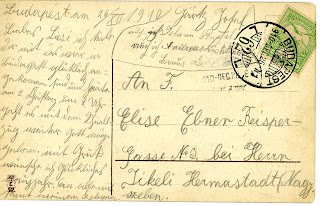But I didn’t always know about the love expressed in language as flowery as the blue-bedecked bicycle pictured on the front. In fact, before last year, I didn’t know this postcard existed.
It was one of scores of missives my grandmother had saved for almost seventy years. “Trash or treasure?” My brothers and I debated, in a frenzy of sorting after my mother’s death. We squinted at the illegible writing, written in an ancient German script that most present-day Germans can’t read much less a German major like me. We decided to keep them, but I figured they’d languish for years in “Box 14, Gartz Correspondence” and end up summarily tossed.
Enter fate.
My brothers and I traveled to Transylvania in 2007 on a family roots-finding mission. In Sibiu (called Hermannstadt by the Germans), we met Professor Uli Wien who was researching the history and immigration of Siebenbürgen Germans — people like our grandparents. Uli asked for our email addresses.
I forgot all about Uli until the summer of 2009, when he emailed me. “Do you by any chance have any letters to or from your grandparents?”
Did I have letters! My heart leapt at what this meant. Perhaps Uli could help me decipher the inscrutable writing! That put me on a mission to look at the letters closely for the first time in the fifteen years since Mom’s death—and I began to tease out some authors’ names.
F[räulein]Elise Ebner
Reisper Gasse [Street]
c/o Mr. Ji[c]keli [the family for whom my grandmother worked]
Hermannstadt
Nagyszeben
I recognized my grandfather’s signature: “Josef Gärtz,” and I knew I had a treasure.Printed under the bicycle on the front:Herzlichen Glückwunsch zum Namenstag. “Heartfelt Good Wishes for your Name Day.”
I sent a xerox of the writing to Uli, and he deciphered into modern German those words written one hundred years ago today. I translated Josef’s sincere, flowery note into English, its tinges of 19th century formality not diminishing its sweetness:
I wish you much happiness and best of health on your cherished Name Day, so you can keep this happy day blooming for many years into the future. A joyful “Hail! and Cheers!” rings out on this day of the flower. [He may be comparing Lisi to a flower]. Long live the pretty girl and faithful Lischen [an endearment for Lisi—ike sweet Lisi].
Yours faithfully,
J[osef] G[ärtz]
Neppendorf, November 18. 1910
[Neppendorf was my grandfather’s home town]
Celebrating one’s Name Day has been a European tradition for centuries—and was a bigger event than a birthday. Parties, gifts, candy, and cards like this one, all were part of the day. Josef and Lisi were Lutherans, and on the Lutheran calendar, Elisabeth’s Name Day is November 19th. Josef mailed this postcard a day ahead, his loving words now reaching us across the span of 100 years.
I know love when I see it.


Linda, I am looking forward to joining you on this journey. How lucky you are to have such wonderful treasures and your writing is absolutely beautiful.
Sweet story. I think it’s remarkable that the German on this postcard is unreadable today by modern Germans. Things change more quickly than we realize.
Lynn, Thanks for your kind comments. I’ve been following your blog for several months, and it was an inspiration for me to get started. Looking forward to more exchanges.
Everything is falling into place so we can follow you and your family on your memoir journey.
OCWW —
And changing more quickly every moment in this brave new world of social media. The Postcard was the text message of its day. I wonder how we’ll communicate in just a few years hence?
Susan,
Thanks for all the support. I’m eager to follow your blog at http://www.mikeandollie.com to see how your preemies made it to happy, healthy young adulthood.
Hello Linda, I came here because you commented a photo blog of mine, and, I got stuck to your pages. I loved this 100 years old love postcard. Pure live history. Thank you for sharing and definitely I’ll came back to read more. Greetings from Sahara Desert!
Thanks Joao —
I hope you do come back and I’ll enjoy your photos. Sahara Desert — cool! or HOT!
LINDA – IT IS A JOY TO FOLLOW YOUR JOURNEY. I DIDN’T EXPECT IT TO BE SO EXCITING. KEEP IT COMING.
NANCY DEGRAZIA